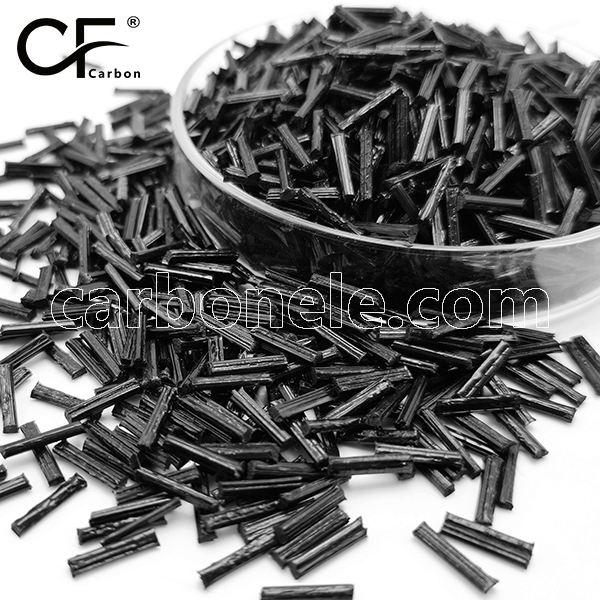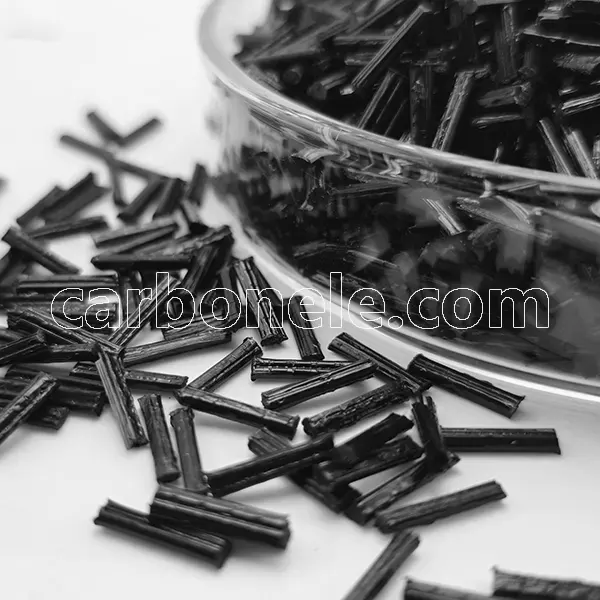Comparisons Of PA66 With Different Carbon Fiber Contents - Carbon Fiber Compounds Manufacturer | Supplier
PA66-CF composites are widely used in many industrial fields due to their excellent properties. Carbon fiber, with its high strength, modulus, and good thermal and electrical conductivity, enhances PA66’s performance. But as the CF content in PA66 changes, its properties vary. The following is a detailed comparison.
Mechanical Properties
– Tensile Strength:
– Tensile strength measures a material’s resistance to deformation and fracture under axial tensile loads. Pure PA66 has some tensile strength. When CF is added, things change.
– Starting from 5% CF content, the fibers in the PA66 matrix act like “skeletons”, sharing loads. At the microscopic level, they form a bonding force, transferring loads. Data shows PA66 + 5%CF’s tensile strength can increase by about 20% compared to pure PA66.
– As the CF content rises to 10%, more fibers carry loads, and the tensile strength increase is more obvious, about 35% higher than pure PA66. The fiber distribution density increases, enhancing tensile resistance.
– When the CF content reaches 20% or more, the tensile strength still rises but the increase slows. Higher CF content may affect fiber dispersion uniformity, causing some fibers to not work fully and local stress concentration. Even so, PA66 + 20%CF’s tensile strength can be over 50% higher than pure PA66, useful in applications needing high tensile strength like aerospace lightweight components.
– Flexural Strength:
– Flexural strength shows a material’s resistance to flexural loads. Adding CF to PA66 significantly improves it.
– For PA66 + 10%CF, when under flexural loads, the CFs are arranged along the stress direction, preventing crack initiation and propagation. The high modulus of CF helps maintain shape during deformation, providing extra support. Experiments show its flexural strength is about 40% higher than pure PA66.
– When the CF content increases to 15%, the fiber network inside becomes denser, better collaborating to resist deformation, further increasing the flexural strength by about 20% compared to PA66 + 10%CF, suitable for components like automobile engine brackets that need to withstand large flexural stresses.
| CF Content in PA66 | Performance and Principle under Flexural Loads | Increase in Flexural Strength Compared to Pure PA66 | Examples of Applicable Components |
|---|---|---|---|
| PA66 + 10%CF | The CFs are arranged along the stress direction, preventing crack initiation and propagation. The high modulus of CF helps maintain shape during deformation, providing extra support. | About 40% higher | – |
| PA66 + 15%CF | The fiber network inside becomes denser, better collaborating to resist deformation. | Further increased by about 20% compared to PA66 + 10%CF, suitable for components like automobile engine brackets that need to withstand large flexural stresses. | Automobile engine brackets |
– Impact Strength:
– Impact strength measures resistance to instantaneous impact loads, crucial for materials in some impact scenarios.
– Within a certain range, as the CF content increases, PA66’s impact strength rises. CFs can absorb and disperse energy during impact, reducing crack generation and propagation. For example, PA66 + 10%CF’s impact strength is about 30% higher than pure PA66.
– But when the CF content exceeds 30%, too many CFs limit PA66 molecular chain movement, causing the material to be unable to consume energy effectively through chain deformation, and the impact strength decreases.
Thermal Properties
– Heat Deflection Temperature:
– Heat deflection temperature is when a material starts to deform under a certain load, related to its performance in high-temperature environments.
– Carbon fiber has high thermal conductivity and low thermal expansion coefficient. When combined with PA66, it improves PA66’s thermal properties. Pure PA66 has a relatively limited heat deflection temperature.
– As the CF content gradually increases, like in PA66 + 15%CF, the CFs in the matrix act like “heat dissipation channels”, conducting heat and inhibiting thermal expansion at high temperatures. Experimental results show PA66 + 15%CF’s heat deflection temperature can increase by about 30°C compared to pure PA66.
– When the CF content reaches 25%, the improvement is more obvious. PA66 + 25%CF’s heat deflection temperature can increase by 30°C – 50°C compared to pure PA66, enabling it to maintain good dimensional stability and mechanical properties in high-temperature applications like around automobile engines or in electronic device high-temperature areas.
– Thermal conductivity determines a material’s heat conduction ability, important for rapid heat dissipation applications.
– As the CF content increases, PA66’s thermal conductivity gradually increases. Carbon fiber forms more heat conduction paths in the PA66 matrix.
– Taking PA66 + 10%CF as an example, its thermal conductivity can be increased by approximately 50% compared to pure PA66. This allows the material to effectively dissipate heat in electronic device heat dissipation components like a computer CPU’s heat sink, ensuring normal operation and preventing performance degradation or device damage due to local overheating.
– When the CF content is further increased to 20%, the increase in thermal conductivity is more significant, providing better heat dissipation solutions for applications with extremely high heat dissipation requirements.
Electrical Properties
– Conductivity:
– Carbon fiber has good electrical conductivity. So, as the CF content in PA66 increases, its conductivity significantly increases.
– When the CF content is 5%, PA66 + 5%CF already has some conductivity. Its surface resistance can be reduced to a certain extent, usable in applications with low conductivity requirements like ordinary electronic device shells. Static electricity accumulation can be prevented by electrostatic grounding.
– As the CF content increases to 10%, PA66 + 10%CF’s conductivity is significantly enhanced. The conductive paths inside are more complete, suitable for manufacturing electronic components like sensor shells that require moderate electrical conductivity for signal transmission.
– When the CF content reaches 20%, PA66 + 20%CF’s conductivity is even stronger, usable for manufacturing electronic components and sensors that require high electrical conductivity. For example, in some high-precision electronic measurement instruments, it can be used as a conductive part to ensure accurate signal transmission and instrument operation.
– Static Dissipation Properties:
– Higher CF content can improve PA66’s static dissipation properties, reducing surface resistance and preventing static electricity generation and accumulation.
– In chemical and electronic manufacturing fields sensitive to static electricity, static electricity generation can cause safety accidents. PA66 with 15%CF or more has good static dissipation properties, quickly conducting static electricity away when the surface has static electricity, maintaining electrostatic balance and providing safety guarantees for production.
Wear Resistance Properties
– Carbon fiber addition significantly improves PA66’s wear resistance.
– Microscopically, the CFs form a “reinforcement layer” on the PA66 matrix surface. When friction occurs, the CFs can bear part of the friction load, reducing matrix wear.
– As the CF content increases, the surface hardness and wear resistance are further enhanced. For example, PA66 + 10%CF’s wear resistance is about 1.5 times higher than pure PA66.
– When the CF content reaches 15%, PA66 + 15%CF’s wear resistance is 2 – 3 times higher than pure PA66, suitable for components like gears, bearings, and guide rails that need to withstand long-term friction and wear.
– When the CF content is 25%, its wear resistance is even more excellent, effectively extending the service life of components in high-wear environments like some mining machinery parts.
Processing Properties
– Flowability:
– Generally, as the CF content increases, PA66’s flowability decreases. The added CFs increase the material’s viscosity, raising the flow resistance of the melt during processing.
– In injection molding etc., when the CF content reaches 10%, processing parameters need to be adjusted. For example, usually, the processing temperature may need to be increased by about 10°C – 20°C, and the injection pressure by about 20% – 30% to ensure smooth mold filling.
– When the CF content is further increased to 20%, the adjustment requirements for processing parameters are more stringent. Further increasing the processing temperature and injection pressure etc. may be needed to overcome poor flowability due to high CF content and ensure product molding quality.
– Molding Shrinkage Rate:
– The increase in CF content reduces PA66’s molding shrinkage rate. The CFs restrain the material’s contraction during cooling, improving the dimensional accuracy of the product.
– Taking PA66 + 10%CF as an example, its molding shrinkage rate is reduced by about 30% compared to pure PA66. This is significant for manufacturing components with high dimensional accuracy requirements like precision instrument shells or some high-end machinery small components, ensuring product dimensions meet design requirements.
– When the CF content reaches 20%, the molding shrinkage rate of PA66 + 20%CF is reduced by 50% compared to pure PA66, further improving the dimensional accuracy of the product, performing well in applications with extremely high dimensional accuracy requirements.
Cost
– Carbon fiber is relatively expensive. So, as the CF content in PA66 increases, the material’s cost also rises.
– For applications with not particularly high performance requirements, a PA66 with lower CF content can be chosen to reduce cost. For example, in manufacturing some ordinary plastic products, choosing PA66 + 5%CF may meet basic strength, wear resistance etc. requirements while keeping the cost within a reasonable range.
– For high-end applications with strict performance requirements, the CF content can be appropriately increased to obtain better performance. For example, in manufacturing key structural components in the aerospace field, to meet multiple performance requirements like high strength, heat resistance, conductivity etc., PA66 + 20%CF or even higher content may be chosen. Although the cost is high, it can ensure the performance and safety of the components.
Through a detailed comparison of PA66 with different CF contents in various properties and cost, we can accurately select the appropriate PA66 material with a suitable CF content according to specific application requirements, achieving the best balance between performance and cost and promoting related field development.
Previous News
Multifunctional carbon fiber composites for ele...Next News
What’s Carbon New Material?
Feature Product
-
PA12 LCF30 for Drone Fuselages & Wings
What do you know about PA12 LCF30? PA12 ...
-
Competitive Price PA6 LCF30 Composites
What’s it? PA6 LCF30, which stands...
-
ABS CF10 Compound ABS 10%CF Thermoplastic Compo...
What’s ABS CF10? ABS CF10 refers t...









